Strength–Ductility Matching Mechanism for Multi-Phase Microstructure Control of High-Ductility Ship Plate Steel
Abstract
:1. Introduction
2. Materials and Methods
2.1. Materials and Process
2.2. Mechanical Tests
2.3. Microstructure Characterization
3. Results and Discussion
3.1. Microstructure
3.1.1. Microstructure Recognition
3.1.2. XRD and TEM Analysis of Dislocation
3.2. Mechanical Properties
3.3. Analysis of Strength–Ductility Matching Mechanism
3.3.1. Effect of Different Microstructure Types
3.3.2. Effect of Branch Cracks on Ductility
3.3.3. M/A Island and LP on Tensile Failure Behavior
4. Conclusions
- (1)
- After image recognition of GB, M/A islands, and degenerate LP, it was confirmed that ST830-FT740 with the structure of “QF + GB + M/A islands + fewer LPs” had the best strength and ductility match.
- (2)
- The ductility decreased linearly with the decrease in dislocation density, the increase in the proportion of LAGBs and mean KAM, and the decrease in the proportion of recrystallized grains and soft grains. There was an upward trend in strength, but anomalies occurred when the structure was similar. Compared with ST740-FT600 whose structure was dominated by more LPs and fewer M/A islands, the dispersion strengthening effect of more M/A islands in ST830-FT600 contributed about 55 MPa to the improvement of yield strength.
- (3)
- The longer branch crack generated at the main crack effectively relieved the stress concentration at the crack tip, which was beneficial to the improvement of ductility. The crack originated from the vicinity of soft grains, and the hard grains with low SF had a more significant effect on crack deflection than HAGBs.
- (4)
- The dispersed M/A islands were beneficial to the accumulation and uniform distribution of dislocations, and also brought about a more stable γ-fiber, which slowed down the generation of defects and maintained plastic deformation for a longer time. Fine M/A island grains had a hindering effect on the growth of micro-voids, while LPs mainly depended on the orientation of the lamellae, and only multiple orientations had the ability to coordinate deformation.
Author Contributions
Funding
Institutional Review Board Statement
Informed Consent Statement
Data Availability Statement
Acknowledgments
Conflicts of Interest
References
- Mallam, S.C.; Marit, W.A.; Aas, J. Reintroducing the Sharp-End Operator to Organizational Learning: How Accident Reports Are Used by Maritime Officers. Saf. Sci. 2022, 147, 105632. [Google Scholar] [CrossRef]
- Park, M.; Kim, J.; Pyo, C.; Son, J.; Kim, J. Research for the Optimal Flux-Cored Arc Welding Process of 9% Nickel Steel Using Multi Object Optimization with Solidification Crack Susceptibility. Materials 2021, 14, 1659. [Google Scholar] [CrossRef] [PubMed]
- Song, Z.J.; Hu, Z.Q.; Ringsberg, J.W. Critical Void Volume Fraction Identification Based on Mesoscopic Damage Model for NVA Shipbuilding Steel. J. Mar. Sci. Appl. 2019, 18, 444–456. [Google Scholar] [CrossRef]
- Wang, D.; Zhang, P.; Peng, X.D.; Yan, L.; Li, G.L. Comparison of Microstructure and Mechanical Properties of High Strength and Toughness Ship Plate Steel. Materials 2021, 14, 5886. [Google Scholar] [CrossRef]
- Luo, Y.; Li, W.; Zhou, P.W.; Xu, Y.T.; Pang, H.Y.; Zhong, N.; Jiao, H.S.; Jin, X.J. Effect of Tempering on Carbides and Hydrogen Embrittlement in E690 High Strength Marine Structural Steel. J. Iron Steel Res. Int. 2022, 1–14. [Google Scholar] [CrossRef]
- He, B.B.; Hu, B.; Yen, H.W.; Cheng, G.J.; Wang, Z.K.; Luo, H.W.; Huang, M.X. High Dislocation Density-Induced Large Ductility in Deformed and Partitioned Steels. Science 2017, 357, 1029–1032. [Google Scholar] [CrossRef]
- Okawa, T.; Yanagita, K.; Inami, A.; Yamada, Y.; Ichikawa, K.; Shirahata, H.; Ishida, K.; Inai, T. Development and Adoption of Steel Plate (NSafeTM-Hull) for Shipbuilding with Improved Collision Safety. Nip. Steel Sum. Metal Technol. Rep. 2015, 110, 30–35. [Google Scholar]
- Man, Z.Q.; Yu, W.; Yang, H.; Chang, W.G.; Cao, Y.F. Effects of Final Cooling Temperature on Microstructure Transformation and Properties of Q550 Low Carbon Bainite Steel. Mater. Sci. Forum 2020, 993, 550–558. [Google Scholar] [CrossRef]
- Isavand, S.; Assempour, A. Strain Localization and Deformation Behavior in Ferrite-Pearlite Steel Unraveled by High-Resolution in-Situ Testing Integrated with Crystal Plasticity Simulations. Int. J. Mech. Sci. 2021, 200, 106441. [Google Scholar] [CrossRef]
- Wu, M.; Zhao, F.; Che, J.L.; Jiang, B.; Zhang, C.L.; Liu, Y.Z. The Toughening Mechanisms of Microstructural Variation and Ni Addition in Direct-Cooled Microalloyed Ferrite-Pearlite Steels. Mater. Sci. Eng. A 2018, 738, 353–361. [Google Scholar] [CrossRef]
- Dong, H.; Wang, M.Q.; Weng, Y.Q. Performance Improvement of Steels through M3 Structure Control. In Advanced Steels; Springer: Berlin/Heidelberg, Germany, 2010; Volume 45, pp. 1–7. [Google Scholar]
- Janakiram, S.; Phani, P.S.; Ummethala, G.; Malladi, S.K.; Gautam, J.; Kestens, L.A.I. New Insights on Recovery and Early Recrystallization of Ferrite-Pearlite Banded Cold Rolled High Strength Steels by High Speed Nanoindentation Mapping. Scr. Mater. 2021, 194, 113676. [Google Scholar] [CrossRef]
- Allain, S.Y.P.; Roth, A.; Bouaziz, O.; D’Eramo, E. Microstructure-Based Behavior Law for Globular Pearlitic Steels. J. Mater. Res. Technol. 2019, 8, 3373–3376. [Google Scholar] [CrossRef]
- Zhao, J.W.; Jiang, Z.Y. Thermomechanical Processing of Advanced High Strength Steels. Prog. Mater. Sci. 2018, 94, 174–242. [Google Scholar] [CrossRef]
- Zhou, W.H.; Wang, X.L.; Venkatsurya, P.K.C.; Guo, H.; Shang, C.J.; Misra, R.D.K. Structure-Mechanical Property Relationship in a High Strength Low Carbon Alloy Steel Processed by Two-Step Intercritical Annealing and Intercritical Tempering. Mater. Sci. Eng. A 2014, 607, 569–577. [Google Scholar] [CrossRef]
- Ismail, K.; Perlade, A.; Jacques, P.J.; Pardoen, T. Outstanding Cracking Resistance of Fibrous Dual Phase Steels. Acta Mater. 2021, 207, 116700. [Google Scholar] [CrossRef]
- Wang, J.; Li, W.; Zhu, X.; Zhang, L.Q. Effect of Martensite Morphology and Volume Fraction on the Low-Temperature Impact Toughness of Dual-Phase Steels. Mater. Sci. Eng. A 2022, 832, 142424. [Google Scholar] [CrossRef]
- Li, X.H.; Liu, Y.C.; Gan, K.F.; Dong, J.; Liu, C.X. Acquiring a Low Yield Ratio Well Synchronized with Enhanced Strength of HSLA Pipeline Steels through Adjusting Multiple-Phase Microstructures. Mater. Sci. Eng. A 2020, 785, 139350. [Google Scholar] [CrossRef]
- Hu, B.; Rong, X.Q.; Tian, C.; Yu, Y.S.; Guo, H.; Misra, R.D.K.; Shang, C.J. Nanoscale Precipitation and Ultrafine Retained Austenite Induced High Strength-Ductility Combination in a Newly Designed Low Carbon Cu-Bearing Medium-Mn Steel. Mater. Sci. Eng. A 2021, 822, 141685. [Google Scholar] [CrossRef]
- Izotov, V.I.; Pozdnyakov, V.A.; Luk’yanenko, E.V.; Usanova, O.Y.; Filippov, G.A. Influence of the Pearlite Fineness on the Mechanical Properties, Deformation Behavior, and Fracture Characteristics of Carbon Steel. Phys. Met. Met. 2007, 103, 519–529. [Google Scholar] [CrossRef]
- Xu, P.W.; Liang, Y.; Li, J.; Meng, C. Further Improvement in Ductility Induced by the Refined Hierarchical Structures of Pearlite. Mater. Sci. Eng. A 2019, 745, 176–184. [Google Scholar] [CrossRef]
- Bansal, G.K.; Srivastava, V.C.; Ghosh Chowdhury, S. Role of Solute Nb in Altering Phase Transformations during Continuous Cooling of a Low-Carbon Steel. Mater. Sci. Eng. A 2019, 767, 138416. [Google Scholar] [CrossRef]
- Sun, C.; Liu, S.L.; Misra, R.D.K.; Li, Q.; Li, D.H. Influence of Intercritical Tempering Temperature on Impact Toughness of a Quenched and Tempered Medium-Mn Steel: Intercritical Tempering versus Traditional Tempering. Mater. Sci. Eng. A 2018, 711, 484–491. [Google Scholar] [CrossRef]
- Elshaer, R.N.; El-Fawakhry, M.K.; Farahat, A.I.Z. Microstructure Evolution, Mechanical Properties and Strain Hardening Instability of Low and Medium Carbon Quenching & Partitioning Steels. Met. Mater. Int. 2022, 28, 1433–1444. [Google Scholar]
- Zhu, W.T.; Cui, J.J.; Chen, Z.Y.; Zhao, Y.; Chen, L.Q. Correlation of Microstructure Feature with Impact Fracture Behavior in a TMCP Processed High Strength Low Alloy Construction Steel. Acta Met. Sin. 2022, 35, 527–536. [Google Scholar] [CrossRef]
- Sun, D.Y.; Liu, C.B.; Long, X.Y.; Zhao, X.J.; Li, Y.G.; Lv, B.; Zhang, F.C.; Yang, Z.N. Effect of Introduced Vanadium Carbide at the Bay Region on Bainite Transformation, Microstructure and Mechanical Properties of High-Carbon and High-Silicon Steel. Mater. Sci. Eng. A 2021, 811, 141055. [Google Scholar] [CrossRef]
- De-Castro, D.; Eres-Castellanos, A.; Vivas, J.; Caballero, F.G.; San-Martín, D.; Capdevila, C. Morphological and Crystallographic Features of Granular and Lath-like Bainite in a Low Carbon Microalloyed Steel. Mater. Charact. 2022, 184, 111703. [Google Scholar] [CrossRef]
- He, X.K.; Yang, Z.Q.; Wang, Z.; Qiao, S.B.; Liu, Z.D. Effect of Mn Content on Microstructure, Tensile and Impact Properties of SA508Gr.4N Steel for Reactor Pressure Vessel. J. Iron Steel Res. Int. 2020, 27, 461–470. [Google Scholar] [CrossRef]
- Xiong, W.M.; Song, R.B.; Huo, W.F.; Yu, P.; Qin, S.; Liu, Z.J. Microstructure Characteristics and Impact Fracture Mechanisms of Nb and V–Ti Micro-Alloyed Offshore Platform Steels. Vacuum 2022, 195, 110709. [Google Scholar] [CrossRef]
- Akhtar, M.N.; Khan, M.; Khan, S.A.; Afzal, A.; Subbiah, R.; Ahmad, S.N.; Husain, M.; Butt, M.M.; Othman, A.R.; Bakar, E.A. Determination of Non-Recrystallization Temperature for Niobium Microalloyed Steel. Materials 2021, 14, 2639. [Google Scholar] [CrossRef]
- Zajac, S.; Schwinn, V.; Tacke, K.H. Characterisation and Quantification of Complex Bainitic Microstructures in High and Ultra-High Strength Linepipe Steels. Mater. Sci. Forum 2005, 500–501, 387–394. [Google Scholar] [CrossRef]
- Xu, X.N.; Tian, Y.; Ye, Q.B.; Misra, R.D.K.; Wang, Z.D. The Significant Impact of the Characteristics of Granular Structure and Granular Bainite on the Mechanisms Contributing to Strength–Ductility Combination. J. Mater. Eng. Perform. 2021, 30, 7479–7487. [Google Scholar] [CrossRef]
- Tomaz, R.F.; Brandão Santos, D.; Camey, K.; Barbosa, R.; Spangler Andrade, M.; Pérez Escobar, D. Complex Phase Quantification Methodology Using Electron Backscatter Diffraction (EBSD) on Low Manganese High Temperature Processed Steel (HTP) Microalloyed Steel. J. Mater. Res. Technol. 2019, 8, 2423–2431. [Google Scholar] [CrossRef]
- Mukherjee, P.; Sarkar, A.; Barat, P.; Bandyopadhyay, S.K.; Sen, P.; Chattopadhyay, S.K.; Chatterjee, P.; Chatterjee, S.K.; Mitra, M.K. Deformation Characteristics of Rolled Zirconium Alloys: A Study by x-Ray Diffraction Line Profile Analysis. Acta Mater. 2004, 52, 5687–5696. [Google Scholar] [CrossRef]
- Mote, V.; Purushotham, Y.; Dole, B. Williamson-Hall Analysis in Estimation of Lattice Strain in Nanometer-Sized ZnO Particles. J. Theor. Appl. Phys. 2012, 6, 6–13. [Google Scholar] [CrossRef]
- Li, X.; Wiskel, J.B.; Henein, H.; Ivey, D.G.; Omotoso, O. Characterization of Microstructure in High Strength Microalloyed Steels Using Quantitative X-Ray Diffraction. In Proceedings of the Biennial International Pipeline Conference, Calgary, AB, Canada, 29 September–3 October 2008; Volume 3, pp. 445–451. [Google Scholar]
- Zhu, W.X.; Zhao, F.; Yin, S.; Liu, Y.; Yang, R.G. Effect of Tensile Deformation on Residual Stress of GH4169 Alloy. Materials 2021, 14, 1773. [Google Scholar] [CrossRef] [PubMed]
- Caballero, F.G.; Roelofs, H.; Hasler, S.; Capdevila, C.; Chao, J.; Cornide, J.; Garcia-Mateo, C. Influence of Bainite Morphology on Impact Toughness of Continuously Cooled Cementite Free Bainitic Steels. Mater. Sci. Technol. 2012, 28, 95–102. [Google Scholar] [CrossRef]
- Sendrowicz, A.; Myhre, A.O.; Yasnikov, I.S.; Vinogradov, A. Stored and Dissipated Energy of Plastic Deformation Revisited From the Viewpoint of Dislocation Kinetics Modelling Approach. Acta Mater. 2022, 237, 118190. [Google Scholar] [CrossRef]
- Mirzadeh, H.; Alibeyki, M.; Najafi, M. Unraveling the Initial Microstructure Effects on Mechanical Properties and Work-Hardening Capacity of Dual-Phase Steel. Metall. Mater. Trans. A Phys. Metall. Mater. Sci. 2017, 48, 4565–4573. [Google Scholar] [CrossRef]
- Chen, Y.N.; Wu, Z.C.; Wu, G.; Wang, N.; Zhao, Q.Y.; Luo, J.H. Investigation on Micromechanism of Ferrite Hardening after Pre-Straining with Different Strain Rates of Dual-Phase Steel. Mater. Sci. Eng. A 2021, 802, 140657. [Google Scholar] [CrossRef]
- Lobanov, M.L.; Danilov, S.V.; Pastukhov, V.I.; Averin, S.A.; Khrunyk, Y.Y.; Popov, A.A. The Crystallographic Relationship of Molybdenum Textures after Hot Rolling and Recrystallization. Mater. Des. 2016, 109, 251–255. [Google Scholar] [CrossRef]
- Radwański, K. Application of FEG-SEM and EBSD Methods for the Analysis of the Restoration Processes Occurring during Continuous Annealing of Dual-Phase Steel Strips. Steel Res. Int. 2015, 86, 1379–1390. [Google Scholar] [CrossRef]
- Liu, Z.G.; Li, P.J.; Xiong, L.T.; Liu, T.Y.; He, L.J. High-Temperature Tensile Deformation Behavior and Microstructure Evolution of Ti55 Titanium Alloy. Mater. Sci. Eng. A 2017, 680, 259–269. [Google Scholar] [CrossRef]
- Gussev, M.N.; Field, K.G.; Busby, J.T. Deformation Localization and Dislocation Channel Dynamics in Neutron-Irradiated Austenitic Stainless Steels. J. Nucl. Mater. 2015, 460, 139–152. [Google Scholar] [CrossRef]
- Ganji, R.S.; Sai Karthik, P.; Bhanu Sankara Rao, K.; Rajulapati, K.V. Strengthening Mechanisms in Equiatomic Ultrafine Grained AlCoCrCuFeNi High-Entropy Alloy Studied by Micro- and Nanoindentation Methods. Acta Mater. 2017, 125, 58–68. [Google Scholar] [CrossRef]
- Zhang, Y.Y.; Wu, H.B.; Yu, X.P.; Tang, D.; Yuan, R.; Sun, H. Microstructural Evolution and Strengthening Mechanisms in CrxMnFeNi High-Entropy Alloy. J. Mater. Res. Technol. 2021, 12, 2114–2127. [Google Scholar] [CrossRef]
- Liu, L.; Yu, Q.; Wang, Z.; Ell, J.; Huang, M.X.; Ritchie, R.O. Making Ultrastrong Steel Tough by Grain-Boundary Delamination. Science 2020, 368, 1347–1352. [Google Scholar] [CrossRef] [PubMed]
- Masoumi, M.; Silva, C.C.; De Abreu, H.F.G. Effect of Rolling in the Recrystallization Temperature Region Associated with a Post-Heat Treatment on the Microstructure, Crystal Orientation, and Mechanical Properties of API 5L X70 Pipeline Steel. Mater. Res. 2017, 20, 151–160. [Google Scholar] [CrossRef]
- Sarkar, A.; Sanyal, S.; Bandyopadhyay, T.K.; Mandal, S. Implications of Microstructure, Taylor Factor Distribution and Texture on Tensile Properties in a Ti-Added Fe-Mn-Al-Si-C Steel. Mater. Sci. Eng. A 2019, 767, 138402. [Google Scholar] [CrossRef]
- Modak, P.; Patra, S.; Mitra, R.; Chakrabarti, D. Effect of Starting As-Cast Structure on the Microstructure–Texture Evolution During Subsequent Processing and Finally Ridging Behavior of Ferritic Stainless Steel. Metall. Mater. Trans. A Phys. Metall. Mater. Sci. 2018, 49, 2219–2234. [Google Scholar] [CrossRef]
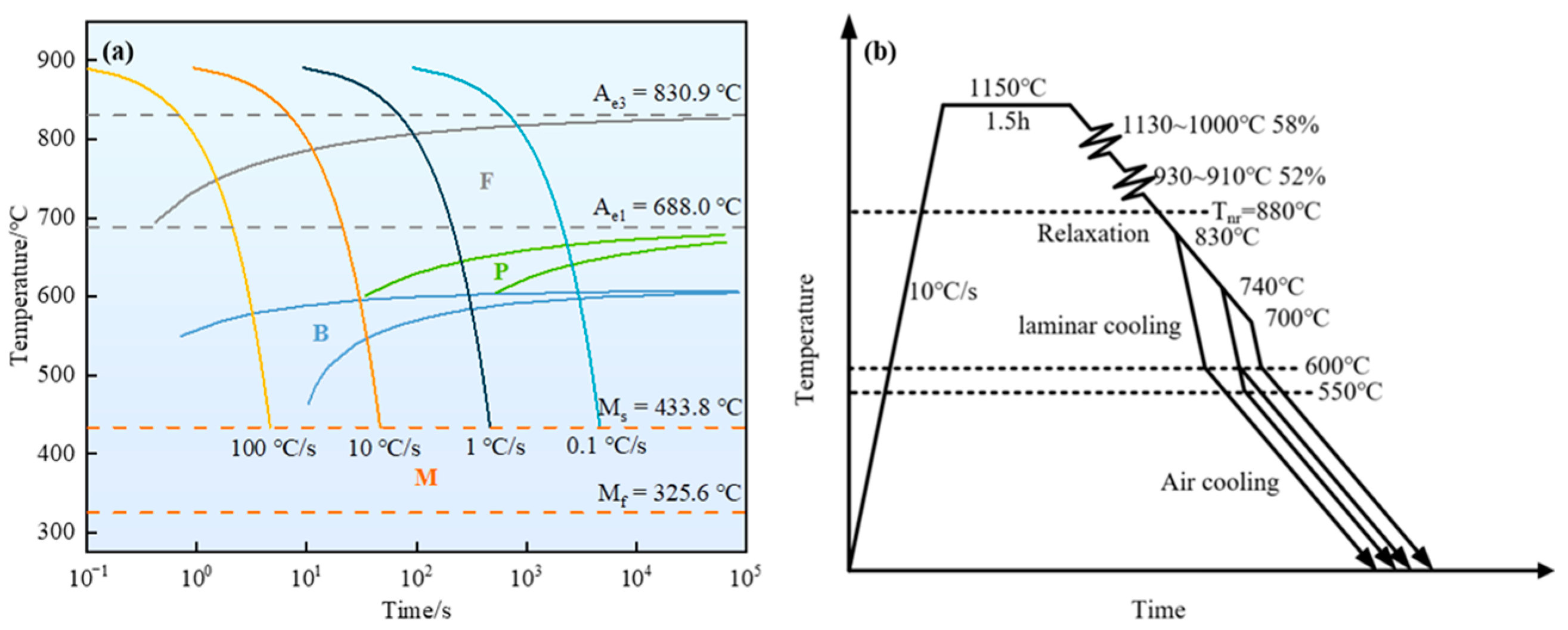


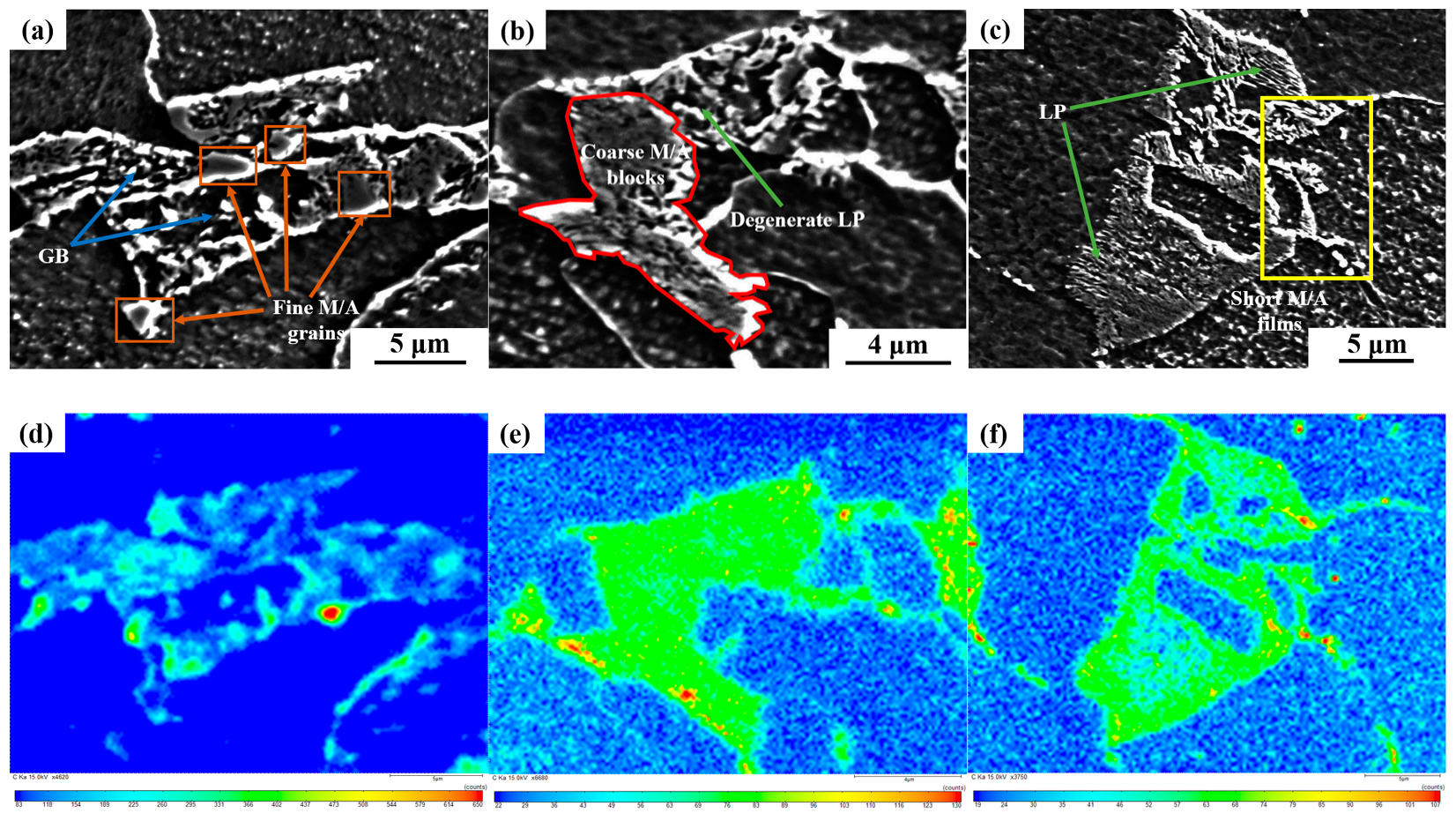




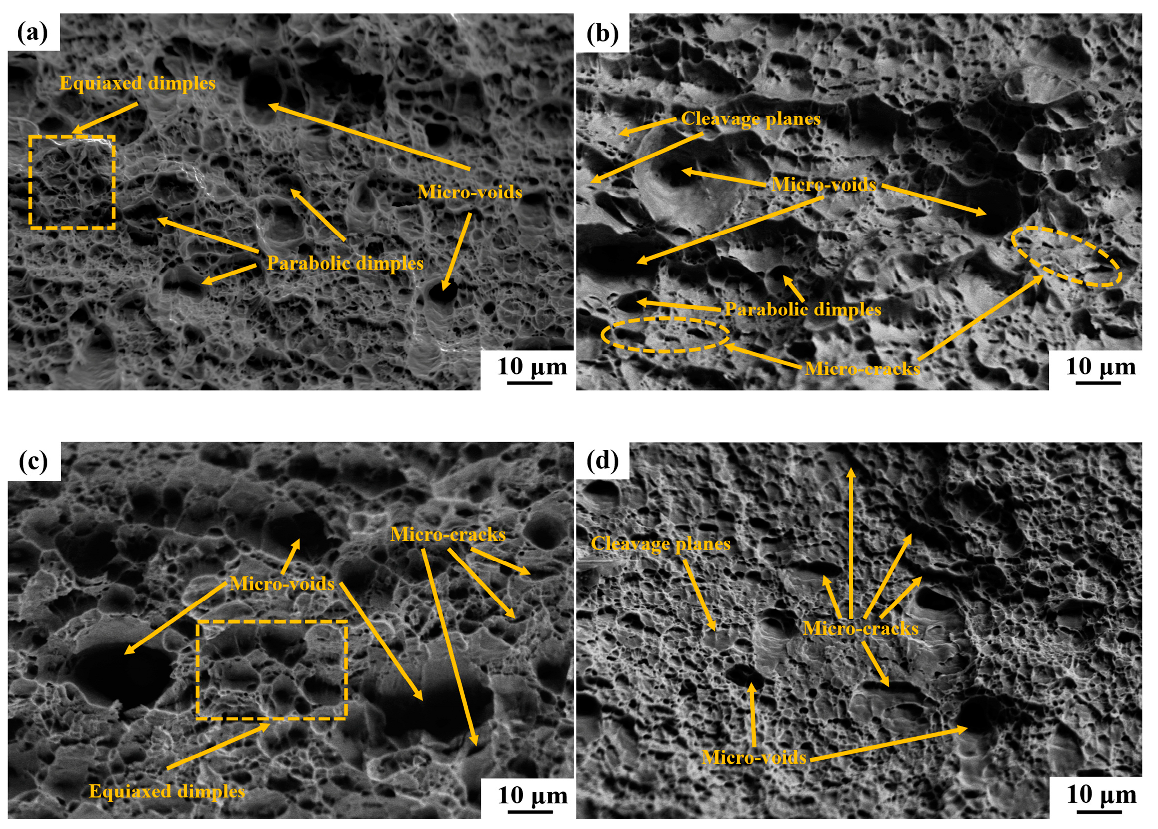

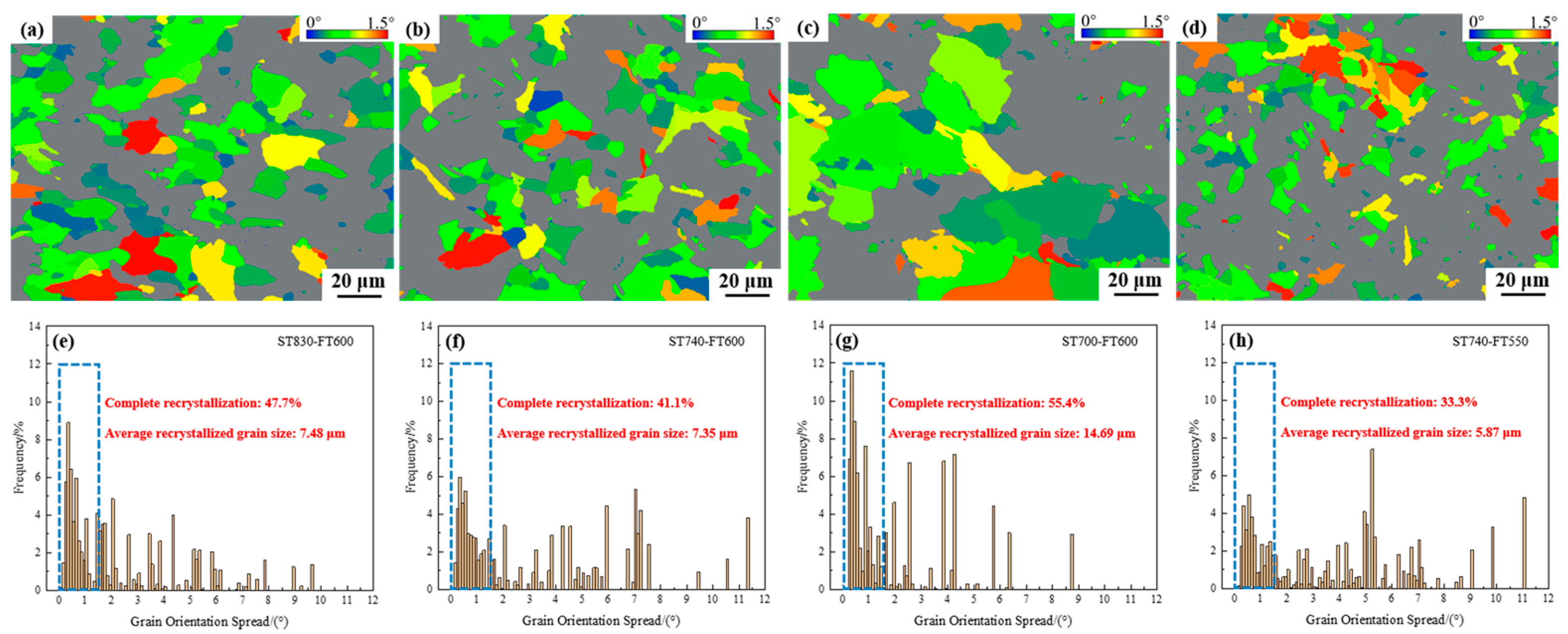
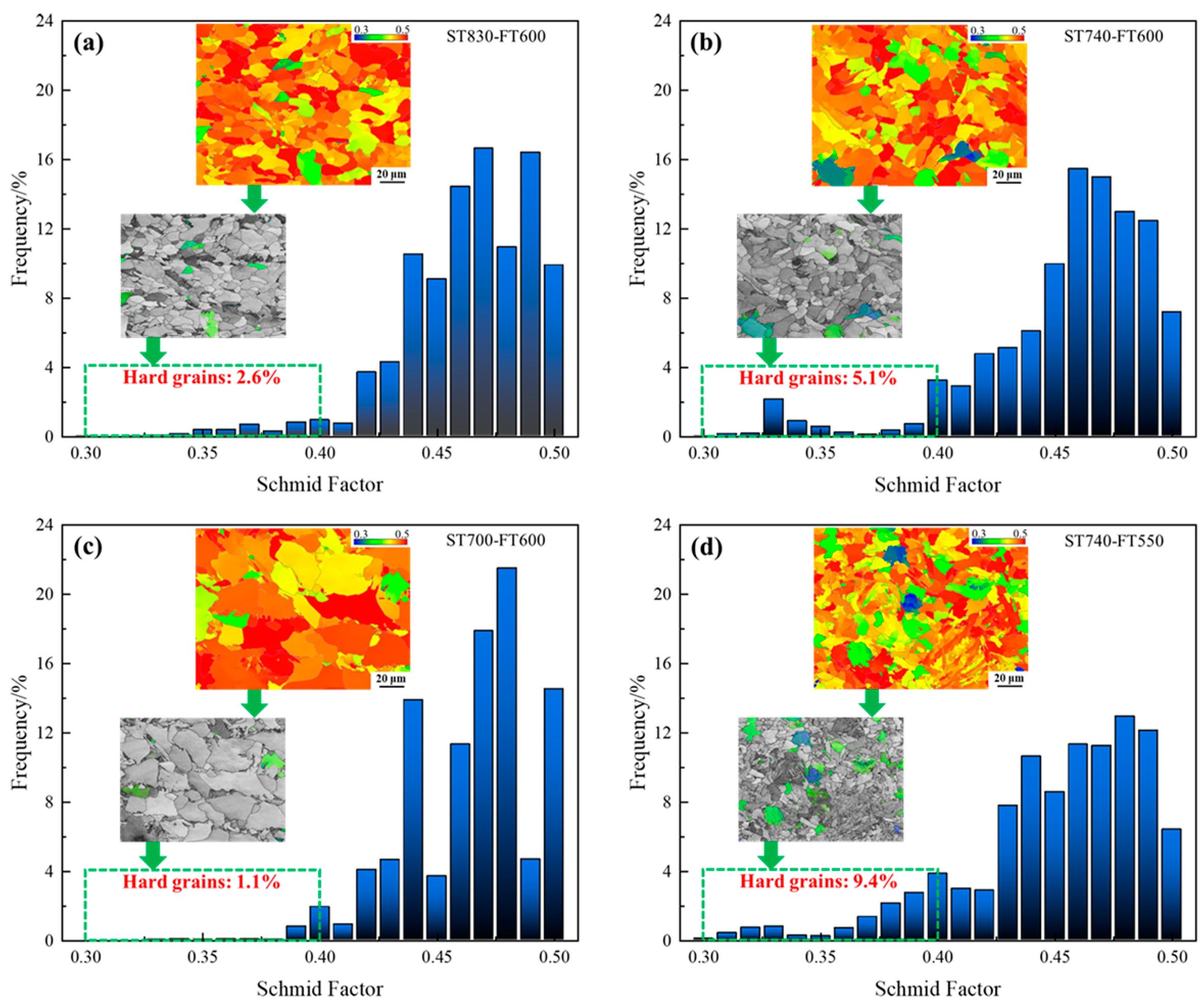






| C | Mn | Si | P | S | Ni | Al | Nb | V | Ti | Fe |
|---|---|---|---|---|---|---|---|---|---|---|
| 0.1 | 1.55 | 0.2 | 0.009 | 0.001 | 0.1 | 0.05 | 0.01 | 0.005 | 0.01 | Bal. |
| Samples | Cooling Rate of Relaxation, °C/s | Starting Cooling Temperature, °C | Cooling Rate of Laminar Cooling, °C/s | Final Cooling Temperature, °C |
|---|---|---|---|---|
| ST830-FT600 | 2.5–3.0 | 830 | 15 | 600 |
| ST740-FT600 | 740 | 600 | ||
| ST700-FT600 | 700 | 600 | ||
| ST740-FT550 | 740 | 550 |
| Samples | F Phase Proportion, % | P + B Phase Proportion, % | F Average Grain Size, μm |
|---|---|---|---|
| ST830-FT600 | 73.3 ± 2.3 | 26.7 ± 2.3 | 9.59 |
| ST740-FT600 | 73.8 ± 1.5 | 26.2 ± 1.5 | 10.95 |
| ST700-FT600 | 66.4 ± 1.8 | 33.6 ± 1.8 | 12.39 |
| ST740-FT550 | 69.6 ± 2.5 | 30.4 ± 2.5 | 9.97 |
Publisher’s Note: MDPI stays neutral with regard to jurisdictional claims in published maps and institutional affiliations. |
© 2022 by the authors. Licensee MDPI, Basel, Switzerland. This article is an open access article distributed under the terms and conditions of the Creative Commons Attribution (CC BY) license (https://creativecommons.org/licenses/by/4.0/).
Share and Cite
Wang, E.; Wu, H.; Mi, Z.; Liu, J. Strength–Ductility Matching Mechanism for Multi-Phase Microstructure Control of High-Ductility Ship Plate Steel. Metals 2022, 12, 1657. https://doi.org/10.3390/met12101657
Wang E, Wu H, Mi Z, Liu J. Strength–Ductility Matching Mechanism for Multi-Phase Microstructure Control of High-Ductility Ship Plate Steel. Metals. 2022; 12(10):1657. https://doi.org/10.3390/met12101657
Chicago/Turabian StyleWang, Enmao, Huibin Wu, Zhenli Mi, and Jinxu Liu. 2022. "Strength–Ductility Matching Mechanism for Multi-Phase Microstructure Control of High-Ductility Ship Plate Steel" Metals 12, no. 10: 1657. https://doi.org/10.3390/met12101657





